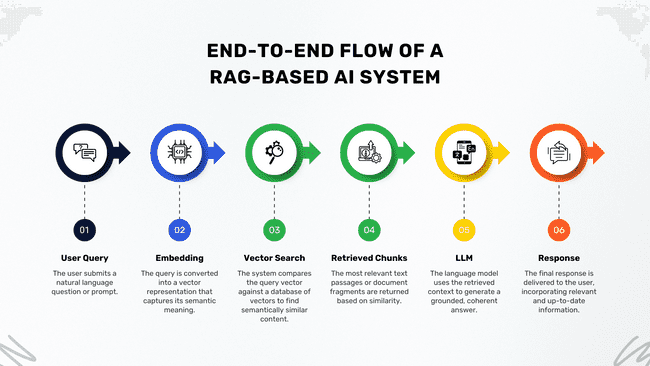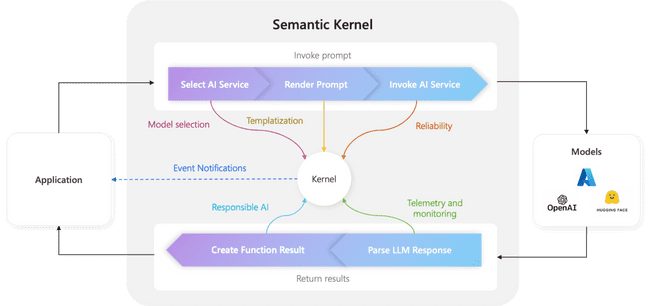Unlocking Modern AI Search: How RAG, Vector Stores, and Semantic Kernel Power Smarter Systems
In recent projects involving AI-driven customer support and dynamic Q&A solutions, our team faced a key challenge: how to provide internal knowledge and documentation to a language model in a meaningful way. Traditional approaches (like injecting static documents into a context window) weren't scalable. That's when we turned to Retrieval-Augmented Generation (RAG) and vector stores, which now form the foundation of our AI architecture.
This article walks through how RAG systems work, how vector stores enable them, and how Semantic Kernel helped us orchestrate these components into a powerful, flexible platform.
RAG systems enhance large language models by retrieving external knowledge at runtime and using it to generate more relevant and grounded responses. Rather than relying solely on what the model learned during training, RAG enables the model to pull in real-time, domain-specific content from external sources, making the answers more accurate and up-to-date.
The key enabler of this approach is the vector store, a specialized database that retrieves information based on semantic similarity. Documents are first broken into chunks, converted into vector embeddings, and stored. When a user submits a query, this is also vectorized and compared against the database to retrieve the most relevant content.
There's a growing ecosystem of vector stores that support RAG use cases. We explored several: Pinecone, Chroma, Milvus, Weaviate, FAISS, and Azure AI Search. Each has its strengths. Some are optimized for low latency, others for multi-modal data, and some are designed for massive scale or open-source flexibility.
In the end, we chose Azure AI Search. While it's not the fastest option, its native integration with Azure, support for hybrid retrieval (combining keyword and semantic search), and built-in enterprise security made it the most practical choice for our environment.
Azure AI Search handles both traditional BM25 keyword matching and vector-based search in a single platform. It integrates with Azure OpenAI for generating embeddings, applies semantic ranking to improve results, and supports secure scaling across large datasets. Its architecture allowed us to simplify our infrastructure while improving performance and reducing maintenance overhead.
As we built out more RAG-based applications, orchestration became a bottleneck. Our original solution (a custom-built orchestrator) handled early requirements, but every new feature required deep modifications. Eventually, we adopted Semantic Kernel, an open-source SDK from Microsoft, to handle coordination between the language model, plugins, memory, and data sources.
Semantic Kernel acts as an AI operating system, allowing developers to combine LLMs with traditional programming and external systems in a single workflow. It provides memory management, supports multiple LLM providers, enables advanced planning features, and includes a flexible plugin system.
For us, it unlocked a new level of modularity. We built plugins to handle embedding generation, document chunking, retrieval logic, and response synthesis. We no longer needed to micromanage orchestration logic. Semantic Kernel took care of function calls, memory tracking, and reasoning over retrieved content.
We've deployed RAG systems across multiple domains. For example, they help employees navigate large document repositories in internal search tools, power AI-based customer support systems that respond using real documentation, and assist researchers by retrieving and summarizing scientific literature. They also support content recommendation engines by identifying semantically related articles or products.
But while RAG opens the door to high-quality, context-aware AI, it brings its own set of challenges. You have to balance how much information to retrieve against the LLM's context window, ensure that relevant context is retrieved, manage response latency due to the extra retrieval step, and keep your knowledge-base fresh. Orchestration becomes especially complex when multiple systems and data sources are involved.
Frameworks like Semantic Kernel are essential here. They help structure this complexity and automate the moving parts so you can focus on outcomes.
RAG and vector search have transformed how AI systems retrieve and use knowledge. They let us combine the generative capabilities of LLMs with the precision of search, producing answers that are not only more accurate, but also traceable and aligned with real data. Orchestration frameworks like Semantic Kernel turn these individual components into production-ready systems.
If you're building anything involving intelligent search, contextual assistants, or AI-driven workflows, understanding these technologies is crucial.
We see RAG and semantic search becoming the norm for building intelligent assistants. The next wave of innovation will likely include smarter hybrid retrieval systems, deeper support for multi-modal inputs like images and audio, deeper integration with structured knowledge graphs, and faster, more compact vector storage.
Semantic Kernel and similar orchestration layers will play a central role in enabling this evolution. As these technologies mature, the gap between static AI responses and dynamic intelligence will continue to close.


